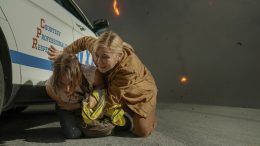It was the only vacation that ever made my wife cry.
She wasn’t alone.
This camping trip had been my friend’s idea – though I admittedly eagerly signed on — and before it was all over his wife cried, too. Not to be left out, their son and both of our kids joined in regularly.
Yeah, it was a tear fest.
Mosquitoes – dense, unrelenting, intense swarms of them – were the reason.
This friend and his family camped at Assateague Island National Seashore on the Maryland-Virginia border the summer before. It had been sort of an impromptu trip, done without much planning, and yet they had a wonderful time. They slept under the stars, fished and swam, all the while surrounded by free-ranging wild ponies and white-tailed and Sitka deer.
“Hey,” he said to me a few months later, “we should all go back again next summer, together. It’s so much fun and the kids will love it.”
“OK, I’m in. Let’s do it,” I answered.
And so we entered the lion’s den.
What none of us realized was that the summer before, when my friend first camped at Assateague, was one of the driest on record in a century. So the island’s notorious mosquitoes were, if not absent, manageable.
By the time we returned, so had those blood suckers. In droves.
The walk-in campsites where we tented are about 100 to 200 feet from the parking lot. It’s another 200 feet or so over the dunes to the ocean.
Every inch of it was torture.
Park officials will tell you – if you bother to ask – that if you plan to camp there, you need to pack lots of bug spray and bring a screened-in tent for protection. We had just a bit of the former and none of the latter.
Exiting the van at the parking area, we were immediately covered in mosquitoes. It was shocking how fast they appeared and how thick were the clouds of them. In a near-manic rush we sprayed ourselves down and ran to set up our tents.
All the while, Viking hordes of mosquitoes tormented us, looting and pillaging their way through our hair, across our skin and sometimes even up our noses.
The rest of the week – or the four days of a planned seven that we lasted — was equally brutal.
Oh, we had some fun. The hours on the beach – in the water and on the sand, cooled by a constant breeze – were great. Seeing the ponies and deer there and outside the tent window each morning was a real treat.
But the hours in between were enough to test your religion.
We ended up buying more insect repellent – after first refusing on principal, given that it cost almost $18 a bottle – from the one store nearby that sold it. We got a screened tent, too. It was barely bigger than the picnic table at our site, especially with seven of us crowded around it.
But we it set up, then huddled inside, unmoving lest we create a gap between the netting and the sand. We refused to drink any more than necessary because that only meant having to sneak out and run the buggy gauntlet to the outhouse 100 feet away.
Four days we lasted. Just four.
Then, dragging tents only partially disassembled, we sprinted across the dunes, threw all of our gear – and probably 20 pounds of sand – into the van and raced away. With all the cheering, it felt like we were successfully outrunning a prairie twister.
We spent our last vacation days in a hotel recuperating.
Our mistakes going into that trip were plenty. We didn’t take the time to learn the conditions we’d face, consequently didn’t prepare for them – mentally or equipment-wise – and didn’t have a backup plan in case things went sour.
As they did, in a big way.
Lesson learned. These days, when planning a camping trip, we run through a checklist of sorts to determine where we want to go, when we want to go there and what we might expect on site.
For starters, when looking at potential areas for camping, we always check websites and blogs and maybe even make a few phone calls to park offices or natural resources folks to find out what kind of conditions – with weather, critters, water levels and the like — we might encounter. That can rule a spot in or out, or at least impact what time of year we might visit.
Local knowledge also highlights what you need to pack and what you can leave at home.
These days, we always ask about accommodations, too. The most primitive of situations might be just what you’re looking for. Or it might not. Maybe some in the group want one thing and others another. It pays to figure out what everyone in your group wants or can at least live with.
We talk about experiences before heading out as well. As in, what kind do we want to have.
Is the campsite the most important thing, or is it just a place to sleep while exploring? Is it important there be as few people around as possible, or do you want to visit places hosting festivals, fairs and the like? Do you want to be able to park at your site, have to walk a bit to reach it, or maybe even have to paddle or backpack there?
The answers to those questions play a big role in choosing destinations.
Budget is another thing to consider, of course. If you’ll need to rent gear on site – like, say, canoes or kayaks — or pay to get into a park or swim or something when you arrive, you have to factor that in, too.
Lastly, it’s always good to go in with an escape plan. If the weather or the bugs become untenable, it’s nice to have some alternatives in mind in terms of where to go, where to stay and what to do. That’s especially true if you’ve got children along.
Camping vacations are supposed to be fun, after all. And most are. Experiences outdoors are the stuff of wonderful memories.
Provided there’s no crying, that is.
Bob Frye is the Everybody Adventures editor. Reach him at (412) 216-0193 or bfrye@535mediallc.com. See other stories, blogs, videos and more at EverybodyAdventures.com.
Packing for your camping trip
The perfect camping spot can turn out to be less than ideal if you don’t have the proper equipment with you.
Here’s a basic checklist of things to pack. Use this as a guide, understanding that your list can change a bit based on where you go and what you plan to do.
Camping Gear
Tent
Battery & propane lantern
Compass, maps and/or GPS
Flashlight
Ground cover or tarp
Shovel
Multipurpose knife or multi tool
Camp axe and saw
Rope, bungee cords, 550 parachute cord or wire
Firewood
Waterproof matches or some other fire starter
Long-nosed butane lighter
Sleeping and Comfort
Airbed or cot
Sleeping bags
Broom and dust pan
Tent repair kit
Pillows
Food preparation
Coffee pot
Salt, pepper and other spices
Plastic zipper bags
Plastic wrap and tin foil
Camp Cooking
Grill and/or camp stove
Stove fuel
Cookware
Utensils
Plates, cups, and bowls
Can opener
Cooler
Trash bags
Water jugs and bottles
Personal items
Extra clothes
Rain gear
Towels
Toiletries
Clothesline
Cards and games
First aid kit
Emergency gear
Camera
Cell phone and charging source
Bug spray
Sunscreen
Sunglasses
Weather radio











































